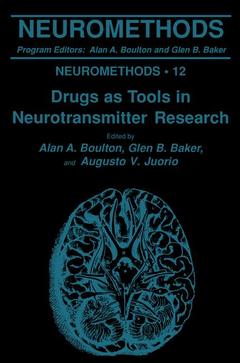Description
Drugs as Tools in Neurotransmitter Research, 1989
Neuromethods Series, Vol. 12
Language: English
Subject for Drugs as Tools in Neurotransmitter Research:
512 p.
· 15.2x22.9 cm
· Paperback
Description
/li>Contents
/li>
Serendipitous discovery has played an important role m the identification of physiological mechanisms in central and peri- eral neurotransmission. In many cases, the subsequent followup of these discoveries has been substantially aided by previouslyiden- fied natural substances that interfered with these mechanisms. The site of neuromuscular blockade produced by curare extracts, for example, was shown in the 1850s by Claude Bernard, and Sir Henry H. Dale m 1906 discovered the reversal of the pressor effects of adrenal extracts by ergot alkaloids. These findings were the first clues that led eventually to the definition of mcotinic cholinergic receptors and the present classification of adrenergic receptors. In the 1950s many discoveries, including the identification of the catecholamines and 5-hydroxytryptamine in the central n- vous system, followed by the development of specific sensitive biochemical and histochemical methods and the introduction of modern psychotropic drugs led to our increased understanding of chemical transmission and the formulation of theories that attempt to explain the causes of some mental disorders. The finding that hydroxylated derivatives of noradrenaline and- hydroxytryptamine are readily taken up by catecholaminergic or serotonergic neurons, and that this is followed by poisoning and death of the cell, encouraged the use of these compounds for the mapping of central and peripheral catecholamine or- hydroxytryptamine systems, and the mvestigation of the re- vance of these pathways to receptor regulation or behavioral - sponses.
Neurotoxins That Affect Central and Peripheral Catecholamine Neurons.- Neurotoxins that affect central indoleamine neurons.- Toxins Affecting Cholinergic Neurons.- GABA Antagonists.- Specificity of Drugs as Tools in Psychopharmacology.- Determination of Monoamine Turnover by Blockade of Their Synthesis or Metabolism.- Dopamine Receptors and Neuroleptic Drugs.- Use of 5-HT Receptor Agonists and Antagonists for the Characterization of Their Respective Receptor Sites.- Biochemical Models of Parkinson’s Disease.- Drug-Induced Behavioral Models of Central Disorders.- Determination of Acetylcholine Dynamics.
© 2024 LAVOISIER S.A.S.
These books may interest you

Catecholamines I 105.49 €



